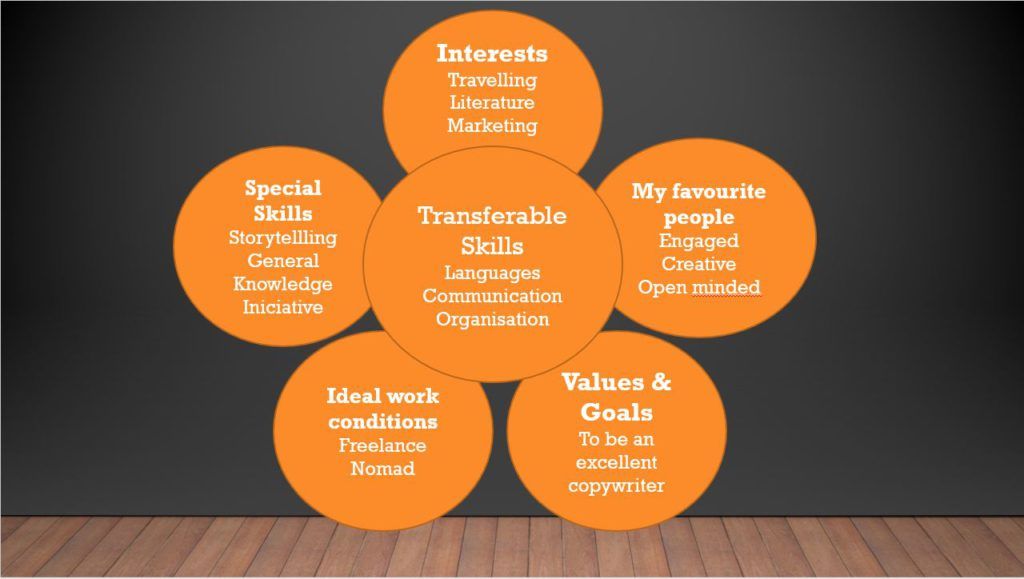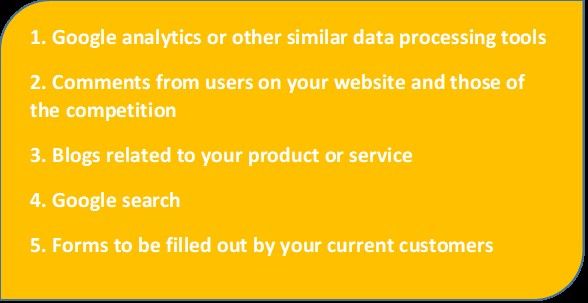Your personal brand is what will set you apart from the rest of the people and businesses out there.
It’s the way you want people to see you, but it’s also the way you want to live your personal and professional life.
It’s your personality and the imprint you leave on others.
People no longer buy just one product or service, they buy from the person or brand behind it all.
Whether you have a business or you want to find a job that you really enjoy where you can demonstrate your full potential, you need to know how to differentiate yourself from the rest with your personal branding statement.
I know it’s not easy, there are many people who are doing things very well (but, remember, also bad) and there are many products or services similar to what you offer.
Still, there is always going to be something that sets you apart from the rest and it’s in that difference that you have to work to succeed with your business or get the job you really want.
There are several steps you should take into account before embarking on promoting your personal brand.
First, you have to know yourself very well to find out what you really want to do and how you want to contribute to society.
Let’s look at the steps you need to take one by one to succeed with your personal brand, but first and foremost, to be happy with what you do.
Are you staying?
Great! Let’s get into it.
The brand building process
1. Draw an outline of who you are and what you want to achieve
The first thing you have to do to identify your personal brand is to know who you really are.
You have to sit back and reflect on your values, abilities and passions. What you like to do and what you’re great at.
To make it easier for you to gather this information and have it all in a format that helps you understand it better, there is a very practical diagram for this type of exercise.
It’s a simple flower. Let’s look at an example.

This would be my flower. Let’s look at each of the petals for a better understanding.
Transferable Skills
In the centre, you must include those skills that you know you have and that are very important but at the same time are transferable and more common.
My skills are languages (I speak 4 languages fluently), communication, I have always expressed myself with ease and I’m organised.
They are important skills but not so special, let’s say they are more common. These skills are the basis of our work and who we are.
Once we have the core we will assemble the different petals of the flower.
Interests
These are those things that really interest you, what you like to talk about and what you always want to find more about. In my case it’s travelling, literature and marketing.
They are things that I love and I do for pure pleasure.
Special skills
They are those skills that are more unique, you know there are not so many people who have them and they distinguish you in some way from the people around you.
In my case, one of them is telling stories, I’ve always been very good at it.
I also have a broad general culture since I read a lot and have a good enough memory to remember what I read.
And the initiative, I’ve always been the first one to suggest and encourage others to do things.
These are more special abilities, those that differentiate you from the people around you.
By this I don’t mean that there isn’t anyone else with these skills, but you do know that there aren’t that many people with that specific combination of skills.
Working conditions
There are people who rather go to an office every day because they don’t like to work alone or because they need a routine.
However, there are other people who prefer more freedom and autonomy and the possibility of being able to work from different places. I belong to this last category.
In this petal you must include your ideal working conditions and the environments in which you are most productive.
Values and objectives
What are your own values? Yes, your own, not those of your father, partner or favourite influencer.
Being clear about your values is very important when creating your personal brand.
If what you do is not in line with your values, you will not be happy with your work or your business and you will probably end up quitting.
Sit down and reflect on what is important in your life, what makes you feel happy and fulfilled.
For example, for you it might be your family. In this case you might need to organise your working life in such a way that it doesn’t demand too much time of your day and thus you’ll be able to spend more time with your family.
Or it might be that your career is very important to you and you want to go the extra mile and create a business that provides you with a luxurious lifestyle. In this case you’ll have to devote a lot of your time to your work and to build up your professional network.
Perhaps what matters most to you are genuine relationships and not so much power and you want to improve the world by contributing your grain of sand, then you will focus on creating a business which helps companies that work for the environment or with people in need.
Your goals will be in line with these values.
In my case, I want to be one of the best copywriters in the world and I want to help small entrepreneurs and professionals succeed with their businesses.
I don’t want a handful of big corporations controlling the market, so I do my bit by helping small businesses succeed.
Your favourite people
It’s also very important to surround ourselves with people who inspire us but also with people we can help.
You have to be clear about what kind of people bring out the best in you and with whom you enjoy collaborating and doing great things together.
Be that memorable person who always does more to help others or to deliver a perfect job. This way you will stand out from the rest and people will remember you.

Image by rawpixel from Pixabay
Consistency and authenticity
Before moving on to the next section I would like to talk to you about two things that are also very important when it comes to establishing your personal brand.
Being consistent with your values and actions is what will give you authenticity in front of others.
In this post I shared my tips for surviving with an online business and definitely being consistent and authentic is what will differentiate your personal brand from all others.
You want to be someone that people can count on and for that you have to be coherent. This means committing to work routines and sticking to them all the time no matter what.
It means being consistent with the time it takes you to respond to emails and phone calls.
Also with your blog, posting regularly.
And the same goes for social media.
Being consistent with the type of content you publish, the tone of the publications and the publication schedule you maintain are things people look at when evaluating your brand.
Make consistency part of your personal brand and practice it diligently.
Being consistent will bring you good results whether you are looking for a better job or if you want to attract new clients.
Now that we know who we are and what we want to achieve, before moving to the next step, let’s see an example of a personal brand.
Neil Patel has become the guru on SEO. He has a very insightful blog and a YouTube Channel where he shares his tips for growing traffic.
He has built his personal brand slowly and he very often tells personal stories about his fails and struggles starting in this business.
He is consistent with what he does.
He promised some time ago, when he bought the tool UberSuggest, that he would add similar functionalities for marketing research as other expensive tools, and that his tool would be free.
And he has delivered. You can get a lot of insight from his tool when it comes to keyword research and content positioning.
People trust him because he has become an authority in his field and is not scared of showing his face.
He is just himself, he doesn’t try to mimic others. I love the way he moves his arms when he talks 😊. It’s his signature!
2. Define your target audience
What you offer and the kind of person you are will interest a certain kind of people, not everyone. You have to be very clear about who those people are.
Study your audience and address them with your message.
If you help your audience achieve their goals, they will help you achieve yours.
For example, if you have a SEO business and you help companies to improve their online positioning, they will help you by paying your fees and recommending you to others.
At first it can be a bit complicated to know exactly who your target audience is.
It will take you some time to get to know the type of audience that is interested in what you offer, however, this is essential in order to be able to attract the kind of people you can help and who in turn will help you.
The main thing here is to understand the motivations of your target audience, what worries them or what interests them.
This will allow you to better design the content of your blog, podcast or marketing emails in order to attract the attention of the right audience.
Resources for getting to know your target audience
There are several ways to define your audience. Time and experience will play a key role because the longer you’ve been offering your product or service, the better you’ll know your customers.
However, if you’re just starting out and don’t have many customers yet, you need to do some research.
For this you have several resources.
Here’s an outline:

Social media is also a very valuable source of information about your potential customers.
Read everything that people post, comments, questions in groups of topics related to your activity, surveys, and so on.
By searching on Google with keywords related to your activity you will be able to find those posts or websites that have more reach and analyse why it is so and what you can offer that is different or is an improvement.
Once you have a very clear idea of who your ideal customer is, everything you do has to be thought out for them. Whenever you create content on your blog and social media, think about whether that person will be interested.
If you don’t think so, then move on and post something else.
What matters is to reach those people by helping them with valuable information or ideas for their life and/or business.
Here’s a post with some tips for creating a content strategy that works.
3. Allie with Influencers
It’s normal, if you just started to create your brand nobody knows you apart from your friends and family who try to support you by sharing your content on social media.
But you have to reach more people.
And how can you reach many more people?
Establishing a relationship with the so-called influencers in your field.
Influencer is a word that has become trendy in the last two years and that is because businesses have realised that they have a lot of power.
An influencer is a person who is popular in a certain sector and has a large number of followers on social media.
There is also another term for them, which is Authority, that is, a person who has a certain authority in a given field.
Since these people are well known within your field, to build a relationship with them can be very beneficial because they’ll be able, precisely, to influence your target customer in order to choose you.

Image by ExpressWriters from Pixabay
Every good relationship is built up little by little, and this one is no exception. You can’t just reach out and ask an influencer to recommend your product or service.
But if you build a relationship of trust and mutual benefit, you’ll have a better chance of being recommended by that person.
One way to do this is, for example, by writing a guest post on their blog. If that blog has more traffic than yours, posting a post there will give you more visibility.
You can also help an influencer somehow with a difficulty that he may have, for instance, he may need a translation or you can give him a hand with some technical obstacle.
There is always something you can do to help him and gain his trust.
That person will thank you by helping you get to know yourself and recommending you to their circle.
It’s about giving and receiving.
Of course there is the option to pay. Some influencers, especially in the fashion sector, charge for recommending products or services. This is something that depends on your budget and your values.
Before we move to the next step in building a brand, let’s see another example of great personal brands.

Henneke Duistermaat is the person behind Enchanting Marketing. She has helped hundreds of writers and small businesses to cut off the s**t and write compelling texts with purpose and joy.
Her blog is so full of helpful tips and encouragement that whenever she launches her online copywriting and blogging courses once a year, these are sold out within hours.
Henneke has managed to create her own successful personal brand by being herself and giving a lot of insight in a very generous way.
She understands perfectly who her target audience is and writes for them (us). She even mentions the people who have given her new ideas for posts by asking questions or commenting on publications.
If you want priceless tips on writing, I recommend you to follow her.
4. Build your assets offline and online
In terms of personal branding, assets are the things you own that will communicate your brand message to your target audience.
Assets are things like your website, your blog, your Twitter username and your LinkedIn profile, for example.
Offline assets are things like business cards and traditional brochures you send.
Website
Check if the domain with your name is available. If it’s not, try a different combination of your name but one that you can identify with and that is easy to remember.
Maybe you are among those who doubt whether it’s better to make yourself known with your own name or with a brand name.
That depends a lot on what kind of product/service you offer.
If what you sell is an activity that you do yourself it is convenient to choose your own name because you are selling your personal brand, i.e. what you do differently from others.
If you prefer to create a brand name you can also do it, but then you need to have a very clear idea of what you sell and what kind of people are your audience.
I’ll give you my own personal brand as an example.
My website has two domains, one is my name, elenadefrancisco.com and the other is my trademark theexpatcopywriter.com.
I bought both domains because my primary value proposition is that I know very well the international customers’ market, also called Expats (those people who live in a country that is not their country of origin).
I chose this brand because it defines my ideal client (businesses that want to sell to international customers) and myself, as I am an Expat living in Holland.
But I also wanted to make sure I had my name as a domain in case one day I decide to change my strategy and address a different audience.
This way I can always count on both domains.
That’s why it’s very important that you first think carefully about which domain you want and how you’re going to use it, depending on your audience and your personality.
But remember, having a website is vital because if you only create content on your Facebook page or Instagram account this content is no longer yours and you cannot control it completely.
However, the content you publish on your website is your property and you exercise full control on it, you can modify it or even delete it whenever you want.
Blog
Your content strategy should be clear: address the questions and solve the problems your target reader has.
To know what doubts and problems they have, you need to do a thorough research, as we mentioned in the second section.
Read comments on Facebook groups, questions on Quora and comments on other blogs related to your activity.
Write quality content and find your voice.
Your voice is nothing more than your way of seeing things, don’t try to copy literally what others with more experience than you say or do.
It’s better to give your opinion and go further, offering a new perspective without just repeating concepts.
This way you will get people interested in what you have to say.
Social Media
I don’t think I need to convince you of the enormous power that social media has when it comes to attracting people.
You have to make use of diverse channels, choose those that are more in line with your personal brand.
The most popular are Facebook, Instagram, YouTube, LinkedIn and Twitter.
Image by Gerd Atmann from Pixabay
You don’t have to be in all of them, but it is advisable to use at least two to make sure you reach more people.
Find out what networks your target audience uses and make sure you’re there sharing useful content and responding to comments and questions.
Email marketing is one of the most powerful tools available to build a brand identity.
It´s incredible that something that appeared in our lives more than 20 years ago is still so effective.
That’s why it’s important to use email in order to maintain a more personal relationship with your target audience.
With email you have already entered the personal territory of the customer, she has given you permission (subscribing to your blog or contacting you through a contact form) to enter her mailbox.
So you have to take the opportunity to cultivate a more personal relationship with her by sending only emails that are useful and help establish your brand.
Events
There is no better way to promote your personal brand than by going to events where your target audience is but also other colleagues, in order to learn from each other.
Face to face relationships are still more effective, after all we are social animals and we like human contact.
The best thing is to be able to speak at these events and be part of them.
Offer yourself to give workshops or lectures, even for free, this way you will make yourself known and little by little people will see you as an authority in your field.
If public speaking is light years away from your comfort zone, at least go to these events as part of the audience and take advantage of the breaks and networking time after the event to build more personal relationships in petit comité so you don’t feel overwhelmed.
I know people insist on saying that everyone should be able to speak in public, but the reality is that not everyone is made for it and it’s not a question of having a hard time either.
However, you can also take it as a personal challenge.
Mastering the subject you’re going to talk about helps a lot to be in control and not feel overwhelmed.
Conclusion
Building your personal brand is going to take some time.
It’s something you don’t just do overnight, you have to be persistent and keep moving forward.
Gone are the days when people knew nothing about the individuals behind a brand.
Now we all know who are the brains behind most of the popular brands we follow.
And this is a result of the saturation in the market, there is a lot of everything so in the end, when we choose to buy something and we decide to trust a brand, we do it because, in addition to liking the product or service, we also like the people behind it.
“Human contact is what makes us that, human”.





I’ve learned a lot of things from this post. Thank you for sharing.
Hello,
Happy to hear that. Have a nice day
How do we overcome the bottleneck in personal branding? Thank you for your article!
Hello Stanley,
Thank you for passing by.
Personal branding is a journey. When you start a business you won’t know most likely very well your target audience and how you can differentiate your business from the rest.
It’s important to do research before starting any activity but it’s also impossible to have it all crystal clear since the beginning. With time you’ll start recognising who your customers are and how you can best help them.
There’s always something that makes each individual unique and you have to find that difference in order to build your brand.
You need to get to know yourself better and understand what are your strengths.
It’s good to get inspiration from others but you need to know what are your differences as well in order to build your brand personality.
Try and error will help you on this journey 🙂
Good luck!
Elena
Very well written article. Extremely useful tips and insights.
Thank you Megha for reading my blog and leaving a comment.
Glad to hear that it was useful.
Elena